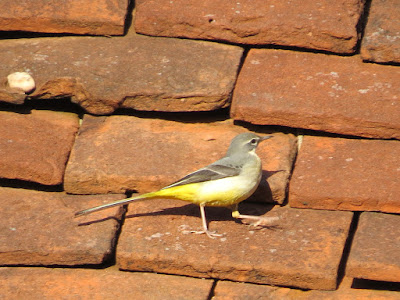The first morning with a bit of sunshine coincided with an early start and resulted in an impressive haul of 61 species. There was also plenty of opportunity to photograph stuff.
The first year-tick was a party of seven
Long-tailed Tits at the edge of Bannams Wood before the sun rose above the horizon. I had decided to park at the church for a change and walk along the road to the southern boundary before walking back across the fields past the flash field.
The wood produced several more little birds, the best being a Marsh Tit, before I was able to get an acceptable record shot of a Goldcrest in the hedgerow just beyond the hamlet.
 |
| Goldcrest |
I have never managed a decent photograph of one of these speedy little birds, and I was pleased to get a recognisable image. Ravens seemed to be particularly common today, and I counted at least six (five together over Bannams), which was a good count for mid-winter.
Once I was off the road the emphasis switched from woodland birds to meadow specialists, and included a flock of at least 45 Meadow Pipits. Chaffinches and Linnets were still present in good numbers and I accumulated 18 Reed Buntings.
 |
| Reed Bunting |
On the other hand Yellowhammers and Skylarks remain in short supply, with just two of each seen. At Netherstead six
Herring Gulls flew north, and three Lesser Redpolls posed in some birches.
 |
| Lesser Redpoll |
I reached the field containing the ex-pool and decided to try to find and photograph a Jack Snipe. To my delight the effort was successful and I managed several images before I got too close and it flushed.
 |
| Jack Snipe |
I also flushed three Common Snipe, while calling birds above Bannams Wood proved to be a pair of
Peregrines.
 |
| Peregrines |
My final year-tick of the day was at the Flash field, where a
Little Owl had opted to sit out in the sun in its favourite oak tree.
 |
| Little Owl |
This is the first time I have seen the species here in January. They normally hide away until spring.
The flash pool themselves were well stocked with birds; a Shelduck, four Wigeon, three Gadwall, nine Teal, 81 Mallard, a Lapwing, three Grey Herons, and a Little Egret.
 |
| Little Egret |
Continuing the walk, I found a flock of corvids which included Rooks which were actually perched. The normal view of them here is a black shape flapping overhead.
 |
| Rook |
A second visit to Netherstead confirmed the continued presence of at least a female Stonechat, and also gave me the chance to photograph another species which is usually only seen in flight here, if at all.
 |
| Starling |
So all in all, a very good visit.





























